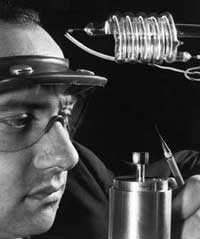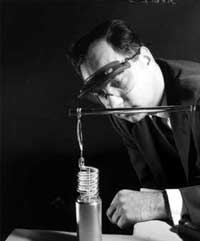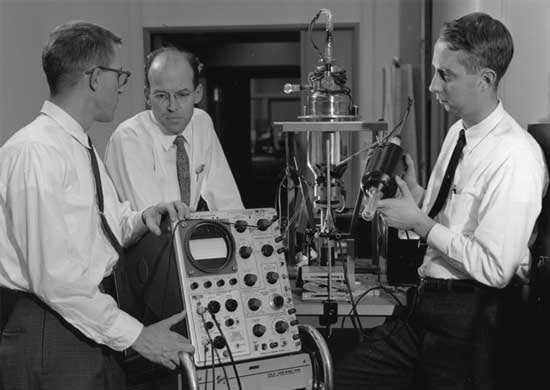The Laser: Its History and Impact on Precision Measurements
Joint session with the FIAP at the 2010 “April” meeting, Washington D.C.
By Daniel Kleppner, Forum Chair
At the "April" 2010 meeting (held in February to be joint with the American Association of Physics Teachers), the FHP and the Forum on Industrial and Applied Physics sponsored "The Laser: Its History and Impact on Precision Measurement" (Session X4). The speakers were Joseph Giordmaine, Federico Capasso, and John Hall. Dr. Giordmaine completed his Ph.D. with Charles Townes at Columbia University on the use of the maser amplifier in planetary astronomy. Later at Bell Labs he worked with ruby lasers, harmonic generation, and nonlinear optics, and is now retired vice president of physical science research at NEC Labs. Dr. Capasso pioneered band structure engineering through molecular beam epitaxy, resulting in electronic and photonic devices dominated by mesoscopic scale quantum effects, including the quantum cascade laser. Dr. Hall, currently a NIST Senior Fellow Emeritus and Fellow at the Joint Institute for Laboratory Astrophysics (JILA), won the 2005 Nobel Prize in physics (with Theodor W. Hänsch) for his work on laser-based precision spectroscopy and the optical comb technique.
Joseph Giordmaine traced the pioneering advances made in the laser during the years 1960-1964, in his talk "The Laser: Historical Perspectives and Impact on Precision Measurements." The seminal concept, stimulated emission, introduced by Albert Einstein in 1917, took nearly forty years to bear fruit. In the mid-1920s, media with an inverted population had been considered by Hendrik A. Kramers, John H. Van Vleck, and Richard C. Tolman, and in the 1930s Hans Kopfermann and Ernst A. Lautenberg saw effects of population inversion on dispersion. Valentin A. Fabrikant in 1939 searched for negative absorption (viz., amplification, excessive stimulated radiation compared to absorbed radiation). Willis Lamb and Ernest Rutherford, Edward M. Purcell, and Joseph Weber all considered implications of negative absorption. However, nobody visualized applications for negative absorption and the matter was not pursued further.
The crucial idea, using an inverted population to sustain oscillations, was conceived by Charles H. Townes (Fig. 1). In a famous incident while he was sitting alone on a bench in Franklin Park, Washington, Townes suddenly realized that if excited atoms were surrounded by a cavity, the radiated energy could build up a field that would sustain the emission. His molecular oscillator consisted of nothing more than a state-selected beam of molecules passing through a microwave resonator. In 1954, maser oscillation was demonstrated in his group by Jim Gordon and Herb Zeiger (the term "maser" was coined that year by Townes). Shortly after, Nikolay Basov and Alexander Prokhorov demonstrated maser operation at the Lebedev Institute. In the summer of 1956, Nicolaas Bloembergen introduced the concept of a 3-level solid state maser, opening the way to the creation of practical maser amplifiers. After extended success with ammonia masers at various laboratories, a ruby maser was constructed at Columbia. In 1964 Arno A. Penzias and Robert W. Wilson used a ruby maser amplifier in their discovery of the cosmic background radiation.
During the summer of 1957 Townes started working with Arthur Schawlow at Bell Labs on the theory and details of an optical maser. That September he had Giordmaine, then a graduate student, witness a notebook entry laying out the general principles. Their proposal, using a potassium medium, incorporated a key idea: an optical cavity without side walls consisting of two parallel mirrors. These ideas were shared with Gordon Gould who coined the acronym "LASER" for "light amplification by stimulated emission of radiation" (Figs. 2, 3). Later, Gould secured patent rights on many of the key ideas. With the publication of the Schawlow-Townes paper, many laboratories set out to create a laser. Theodore Maiman (Fig. 4), at Hughes Research Laboratories (now HRL Laboratories), chose to work with ruby. This seemed like an unpromising source because calculations indicated that the quantum efficiency for pumping would be too low to be practical. Maiman carried out his own calculations and decided that his scheme should work. However, pumping required tens of kilowatts of optical power, whereas other schemes required milliwatts of power. Using a commercial flash lamp to pump the ruby, Maiman successfully demonstrated laser action (Figs. 5-7). His breakthrough was a complete surprise to the community. His letter was rejected by Physical Review Letters because the title included the term "maser", a topic that had had been embargoed by the editors.
Continuous wave operation of a laser was achieved with the He-Ne laser by Ali Javan and W.R. Bennett at Bell Labs and reported on December 31, 1960. Soon after, the output of two lasers was mixed, demonstrating optical frequency stability of better than 1 MHz over a period of 100 seconds. The number of active laser groups grew from 50 in 1960 to 500 in 1962. Most publications came from industrial labs where there was more activity in engineering departments than in physics departments. Numerous basic problems were attacked, for instance the nature of open resonators by A. Gardner Fox and Tingye Li, the theory of unstable resonators by Herwig Kogelnik, and the question of whether semiclassical theory was adequate to describe the laser field. Quantum optics problems became amenable with Roy A. Glauber’s work in 1962, for which he received the Nobel Prize in 2005. Among the discoveries that quickly followed was saturation-narrowing of a spectral line, later called the Lamb dip. In 1961 nonlinear optics was launched by Peter Franken who demonstrated frequency doubling in a solid. Shortly after, two-photon absorption was observed. In the spring of 1961, Giordmaine, guided by Franken’s findings, discovered the significance of phase matching. Another discovery in that period was the power of Q-switching by Bob Hellwarth. The discovery immediately led to the discovery of Raman scattering and had a tremendous impact on nonlinear optics.
Giordmaine noted that although the rate of discoveries in lasers and optics in the period 1960-64 was enormous, applications were slow to come. A ruby laser had been used to treat a retinal tumor, but the revolution in technology due to lasers lay in the future.
Federico Capasso, in his talk "Freedom from Band-Gap Slavery: From Diode Lasers to Quantum Cascade Lasers" described the history of semiconductor lasers as a story of the convergence of different fields in highly interdisciplinary laboratories, primarily industrial and Government labs. Bell Labs, General Electric, IBM, Lincoln Labs, and the Ioffe Institute all played prominent roles. The convergent fields included materials research, particularly thin-film growth technologies, solid-state physics, solid–state electronics, and band structure engineering. In the past, solid-state physics was deprecated by Pauli and other notable physicists, but in fact bandgap engineering now permits the design of materials with desired properties using the tools of quantum theory.
Semiconductor lasers were created in 1962 at GE by Robert N. Hall (Fig. 8) and Nick Holonyak, at IBM by Marshall I. Nathan, and at MIT-Lincoln by Robert Rediker. At the time Capasso was finishing his Ph.D. research under F. De Martini. His advisor recommended that he leave non-linear optics and lasers because the field was saturated. So Capasso went to work on fiber optics, then to Bell Labs where he worked on transport. Ten years later he grew interested in the possibility of laser action between quantum well states pumped by quantum tunneling. He worked on this intermittently for seven years, somewhat hiding the research for fear of losing his job. At one point a higher-up ordered him to stop, but fortunately a higher higherup gave him the OK to keep going. In January 1994, Capasso demonstrated pulsed low-power laser radiation from a quantum well device, though it could operate only at 90K. The significance of his discovery was that the quantum wells could be tailored to be resonant, and could be cascaded using multi-layer films, building up the power and using each electron over and over. Today, continuous wave high power quantum well lasers operate at room temperature.
Quantum cascade lasers operate from the mid-infrared region (3-25 μm), including the important atmospheric transparency windows of 3-5 μm and 8-12 μm. They can produce radiation by difference-frequency mixing modes in the THz region, (60-300 μm). In some cases outputs of watts and efficiencies approaching 50% are achieved. Wide tuning ranges can also be achieved, making these lasers ideal for spectroscopy and population pumping in chemical physics. In addition to telecommunications, applications include atmospheric and tropospheric sensing of greenhouse and trace gases, medical imaging, biomedicine, and security. Development continues with one of the goals being beam engineering—the generation of laser beams with arbitrary wave fronts.
In his talk "Developing Stabilized Lasers, Measuring their Frequencies, Demoting the Metre, Inventing the Comb, and Further Consequences," John L. "Jan" Hall recalled incidents from a career devoted to applying lasers to precision measurements. The field of precision laser measurements was launched with the demonstration of a continuous wave laser by Ali Javan and William R. Bennett at Bell Labs at the end of 1961. Laser physics essentially bifurcated at that point. One stream pursued high power, short times, and nonlinear effects; the other avoided nonlinear effects as much as possible in order to pursue the ultimate in time and power stability. Hall suggested that with the creation of the frequency comb those streams have now rejoined. He traced his obsession with precision measurements to hearing a talk by Javan in which he played a recording of an audio signal generated by mixing the light from two separate lasers. Hall pursued his obsession at the Joint Institute for Laboratory Astrophysics, now JILA, which provided an ideal environment for pursuing this new field. JILA had excellent facilities and, most importantly, excellent collaborators. Alan White demonstrated how to stabilize a He-Ne laser using Zeeman lines for the discriminator, and then Hall and R.L. Barger showed how to stabilize a laser on the Lamb dip. Using a Fabry-Perot interferometer they could then compare a wavelength with the legal krypton standard to 4 parts in 109 in a few minutes. They discovered a narrow line in methane that was well suited to laser metrology and developed a method for locking a laser to the line using an external absorption cell. These techniques became standard practice.
Peter Bender, Jim Faller and Hall undertook a speed-of-light measurement based on standing waves of two neon lines, whose difference frequency could be measured directly. The experiment was carried out in Poorman’s Relief Gold Mine in Colorado using a 30 m evacuated baseline. One of the surprises was a systematic shift in the baseline arising from Earth tide. At about that time Javan published a proposal for measuring the frequency of a laser by using the nonlinearity of a point contact diode to generate high harmonics, starting from an atomic clock. The idea was to span the frequency range from microwave to optical by a series of steps in which a laser would be stabilized to the harmonic of a lower frequency standard, and used to generate the next step in the chain. In 1972 Ken Evenson and colleagues used the method to measure the frequency of a 9.3 micron line of CO2 using three lasers. This dinosaur method was eventually implemented at the Physikalisch-Technische Bundesanstalt (PTB), using 24 phase-locked loops. A collaboration at JILA in which Evenson played a principal role made a series of frequency vs. wavelength measurements and obtained a value for c that was limited only by the precision with which wavelengths could be compared. This effectively rendered obsolete the use of wavelength as a standard for length. In 1983 the speed of light was defined, and the meter was redefined in terms of the distance light travels in a second. By then the artifact meter bar at Bureau International des Poids et Mesures in Sevres, France, had long been obsolete, but this redefinition was not a matter of incremental precision but of fundamental meaning: length, as a primary standard, was now obsolete.
The invention of the frequency chain by the Munich and JILA groups totally changed the landscape for optical frequency metrology. The discovery of the coherence of sidebands in pulsed lasers, and methods for broadening the spectra to span an octave or more, provided an optical "gear chain" that could link frequencies from the microwave to the optical. With this, optical clocks became a realistic possibility. The comparison of an ion-based optical clock at NIST (Boulder) with an atom-based optical clock at JILA, several km away using a fiber-optic line, with an accuracy of about two parts in 1016, marked the beginning of a new era in frequency metrology and a new field of physics based on the control of the phase of optical fields.
Hall has turned JILA leadership into this new era over to his protégé Jun Ye. Meanwhile, he is devoting himself to what he regards as the most critical national need: education. With his wife Lindy he has established Sci-Teks Discovery Program for Kids. For details, see http://sci-teksdiscoveryprogramforkids.org/.
For further reading and references see "Bright Idea: The First Lasers," an on-line exhibit of the Center for History of Physics, Niels Bohr Archive, American Institute of Physics, and an article adapted from it (with permission), "Bright Ideas: From Concept to Hardware in the First Lasers," Radiations 16, 12-16 (Spring 2010) which is also available online.

AIP Emilio Segrè Visual Archives, Physics Today Collection.
Fig. 1. Charles Townes (left) and J. P. Gordon standing with the second ammonia maser at Columbia University, 1955.

Fig. 2. First page of Gordon Gould’s 1957 lab notebook where he defines the term ‘laser’.

Fig. 3. Gordon Gould, circa 1985.

Fig. 4. Theodore Maiman.
AIP Emilio Segrè Visual Archives, Hecht Collection.



Figs. 5, 6. Theodore Maiman with his first ruby laser, 1960.
Photo courtesy of HRL Laboratories; used by permission.
Fig. 7. Structure of the first ruby laser by Theodore Maiman, Hughes Research, 1960.
Photo courtesy of HRL Laboratories; used by permission.

Fig. 8. L-R: Gunther E. Fenner, Robert N. Hall and Jack D. Kingsley, November 1, 1962. Kingsley holds a refrigerated container in which the laser operates at liquid-air temperatures. In the background another laser operates within a container chilled by liquid helium. The oscilloscope makes it possible to observe the shape of pulses produced by the laser.
Note Added: This article represents the views of the author, which are not necessarily those of the FHP or APS.
